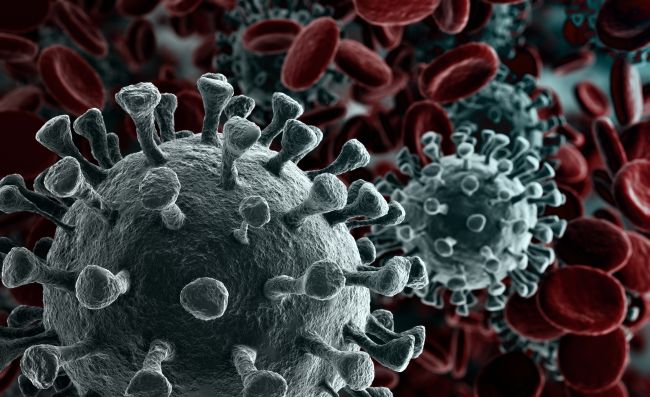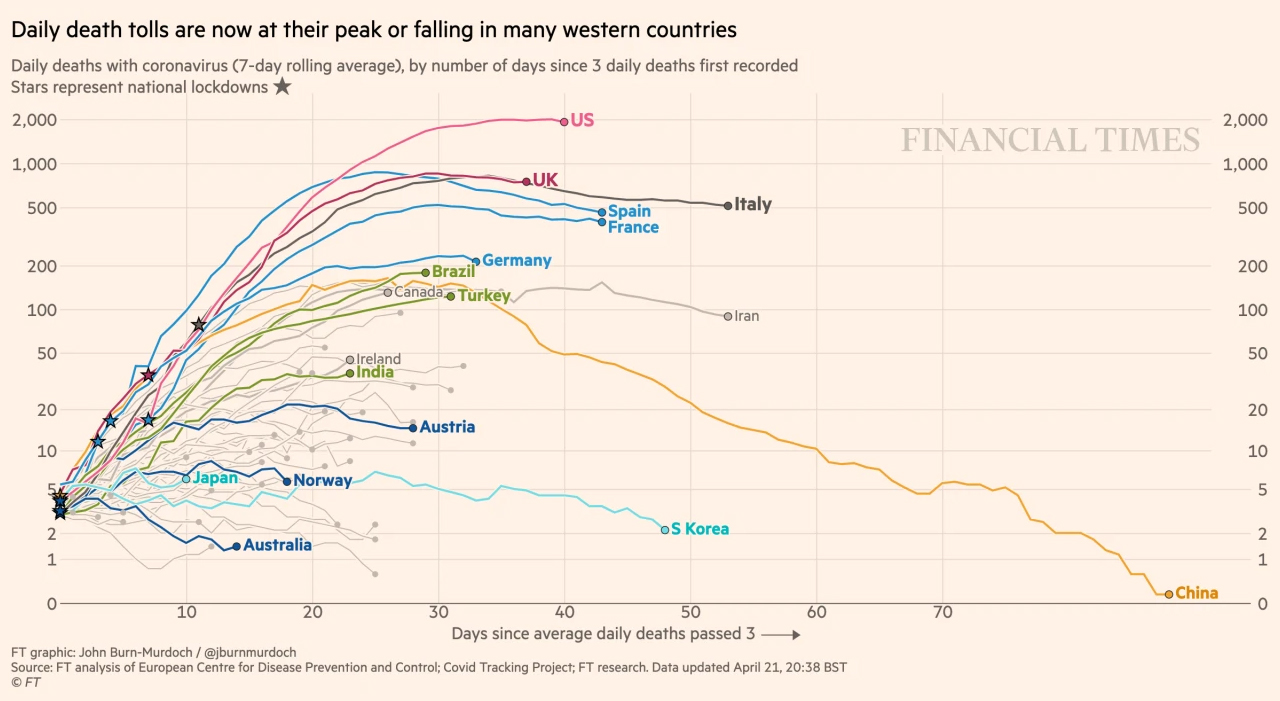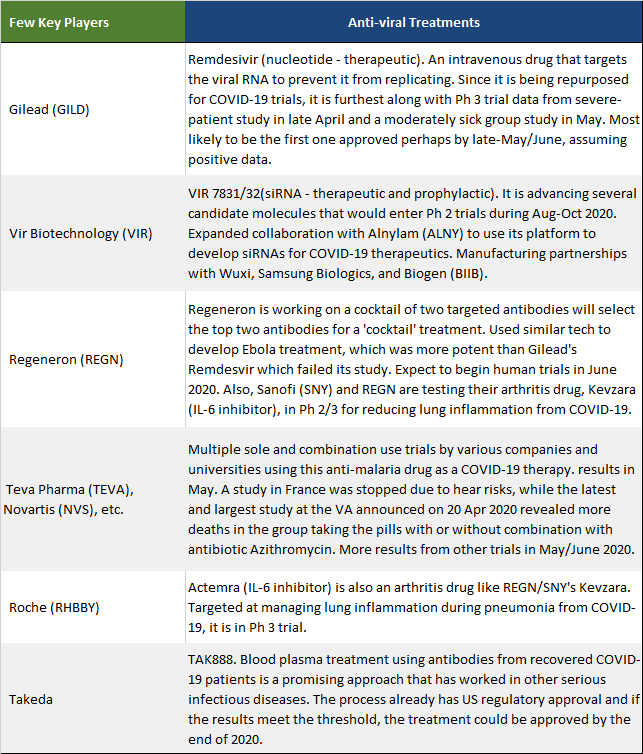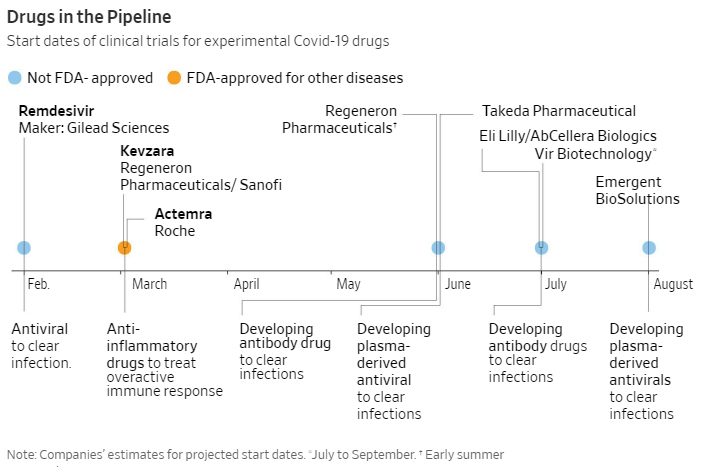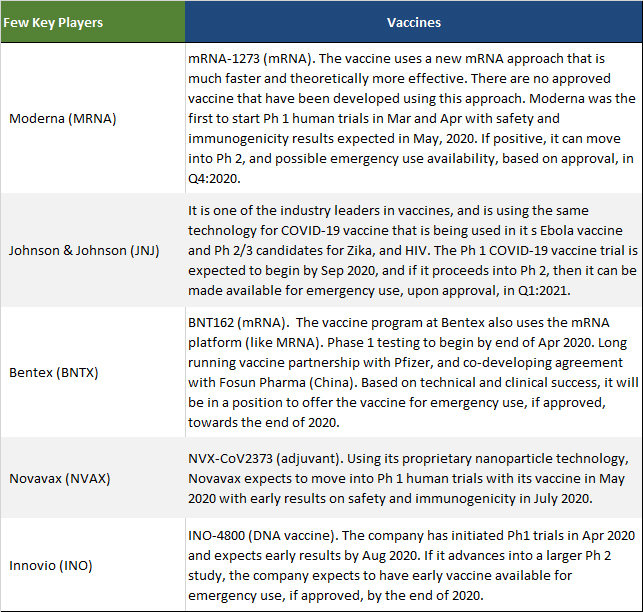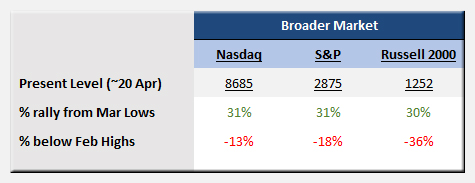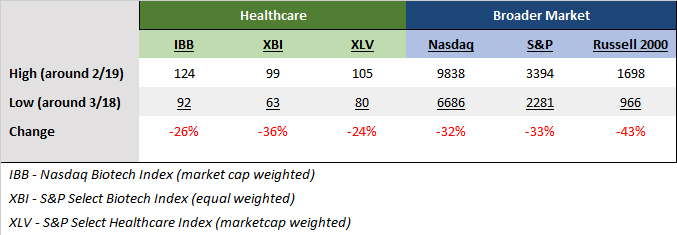Market Pulse
The COVID-19 pandemic has thrust biopharma to the forefront in the search for a solution. And biotechs will remain at the investing forefront as the quest for anti-viral treatments and vaccines continues to be the race for the holy grail that can restore economic activity around the world. It is truly a save-the-world moment for the drug industry, an industry that has been widely despised and consistently polls towards the bottom, even below the Federal Government, in reputation surveys. But healthcare now faces an opportunity to do good against a common viral enemy which can recast its reputation and raise valuations.
We look at the key players and the outlook for biotechs and the stock market. This report builds on the series of earlier reports including, Stock Market's Next Move and Healthcare in a Bear Market.
Daily death tolls are now plateauing in the US for the past week. This is a positive sign as it marks the first step towards recovery.
However, as can be observed from the chart, the US has suffered the most severe daily death toll with a 7-day (weekly) moving average peak of ~2000 fatalities. Thus, the plateauing stage will also be a much longer sideways process similar to the worst affected countries, like Italy and Spain (peak ~900/day). A quicker drop-off like in Australia, South Korea, and Austria is not possible since they were much more successful during the containment phase of the pandemic management.
What Does It Mean For The Economic Recovery?
A daily death toll is a number that distills down the entire pandemic into a single statistic that is a clear tracker of the virus's impact. It is simple to assimilate by the population, is relatively more accurate though understated, has strong psychological implications, and dominates the news cycle. A high level of daily casualties will only allow much smaller steps towards recovery. It is a much harder task to convince the majority of the population to resume normal activity when 1500 to 2000 Americans are dying daily from the disease. And with a long plateauing period the statistic is going to remain stubbornly high for the rest of the month and into early May. This can be inferred by observing the graph line for Italy and Spain where the daily mortalities are still above 500 even two weeks after ending plateauing.
A push to take bigger steps toward economic recovery in short order can end up keeping the daily death toll in a prolonged sideways movement or possibly shift it higher. Already, COVID-19 has killed more Americans in the first three weeks of April than the entire 2019 flu season.
But the economy has to take measured baby-steps as both public health and economic health have to nursed back. It cannot remain a mutually exclusive choice in another 2 to 4 weeks. A slow and highly calibrated approach that gradually builds on the success of each step can prove more productive and durable.
If the US daily death toll, after plateauing, begins to dip faster than other countries with high mortality tolls, that would be a sign of the US finding a more effective approach. But at this time it doesn't seem likely.
Biotech Resurgence
The Nasdaq Biotechnology Index (IBB) has made new 52-week highs since last week. The S&P Healthcare Index (XLV) is just 3% below its all-time high.
With the swirling Charybdis of uncertainty, it is clear that the road towards economic recovery is paved with very serious challenges. The disease has to be managed first, and biotechs are a major part of the solution. It is one of the few industry groups that comprise the arrowhead in the battle to overcome the pandemic.
Vaccines are the eventual and ultimate defense. However, it is hoped they will be broadly available in the second half of 2021. In the meantime, for the world starved of good news on COVID-19, drug treatments are the quickest silver bullet. Anti-viral treatments that can help patients recover and survive will have a direct impact on the daily death tolls, which in turn will boost public confidence. This will allow for more rapid steps towards economic recovery in what can be a 2-year journey back to the Q4:2019 GDP level of $22 trillion.
According to industry research firm Pharma Intelligence, there are over 140 vaccines and drug treatments being developed worldwide just for COVID-19, with 11 of them already in clinical trials. There are another 115 ongoing clinical trials for drugs and vaccines already approved for other diseases and conditions.
Most of the efforts are at the early stages, and many will fail. But it is an incredible undertaking for the global biopharma industry to focus on coronavirus, unleashing significant scientific and financial resources, and rapidly moving in cooperation with regulatory agencies to find a cure.
One has to also keep in mind that traditional timelines have been compressed where they can be, which will result in faster clinical timelines than are typical of normal drug and vaccine development process. The industry and the FDA are on a pandemic timeline where perfection is the enemy of good.
Drug Treatments
Antivirals work by arresting the spread of the viral infection in the cells and preventing it from replicating. A few of the key players are listed below.
Some other companies, in this partial list, pursuing drug treatments include AbbVie (ABBV), Emergent Biosolutions (EBS), Cytodyn, and Kiniksa Pharmaceuticals (KNSA).
In a race against time with the cost being measured in hundreds of lives lost daily and unparalleled global economic devastation, anti-viral treatments are the only possible elixir for the economy this year. Most likely such treatments will begin to emerge from May/June onwards.
Vaccines
Looking at the vaccine landscape, there are many companies focused on developing a COVID-19 vaccine, which will be the best preventive or prophylactic solution. Multiple studies of new vaccines as well as existing ones are underway. The breadth of effort is critical since the clinical failure rate for vaccines is astronomically high, estimated at 91% by the International Vaccine Institute Director-General Jerome Kim. With the long development process and low success rate, one truly hopes a vaccine is broadly available sometime in the second half of 2021.
The stock market has ridden the rising wave of federal stimulus spending, and optimism on the bending of the curve as well as an imminent economic reopening. The broader market has rallied ~30% from March lows, and the larger-cap major indexes are ~15% below all-time highs of February 2020.
The economy is looking at a serious uphill challenge to recover.
In the absence of an imminent cure, some prudent risks will have to be taken to reopen the economy. A slowly expanding phased opening is a reasonable move once healthcare capacity returns to normal levels and supplies are replenished. Perhaps we reach that state in the second half of May. Since there is no uniform national testing and contact tracing policy, the risk of a renewed surge can be high due to uneven focus. Thus, how successful the plan to reopen the economy is will now depend mostly on the ingenuity of the state administrations and their policies.
There is no perfect template. It will be a learning curve requiring quick adjustments. But it is reasonably clear that a fast and broad opening can raise the risk of a viral resurgence, turning a terrible problem even worse. Such an outcome probability has to be minimized. A gradual approach appears prudent until such time there is an approved anti-viral treatment option. That may happen in the May to July timeframe, first with Gilead's Remdesivir and then with other similarly repurposed drugs. When that happens, it can provide the impetus for gradually raising the pace of the reopening effort and broadening its scope.
The stock market is reflecting all this risk above while sitting just about 15% below all-time highs, as observed from the exhibit above. At least a third of the economy has been knocked out. That suggests a much more dire situation, and this was before the implosion in the oil market. But the dire situation has to be balanced with the equivalent amount of stimulus that has been provided by Congress and the gushing credit from the Federal Reserve liquidity hydrant.
One has to look forward, and that's what the stock market is doing. It now comes down to the effectiveness of the reopening effort, which will presage a recovery. In our opinion, it appears too much perfection in a speedy economic recovery is priced-in, at a time when there is no evidence of a single successful and broader reopening in the US or for that matter even outside the US in countries with a similarly devastating high death toll.
The reopening and recovery will not be a linear and smooth process at all, in our opinion. The daily toll chart, shown at the top, will hobble recovery efforts and must come down rapidly to support the argument for a quicker economic recovery. Perhaps the market is looking at an imminent solution from the biotechs. That's good for the healthcare sector. But the overall market at this particular time appears to be more loaded towards downside than upside, and caution is advisable. A silver bullet treatment will boost confidence and improve the pace of what will be a non-linear recovery, measured in years not months, back to the Q4, 2019 level. And along the way, the market will present many opportunities for portfolio growth.
Biotech and Healthcare Outlook
Biotechs have powered higher, and so has broader healthcare. The promise of a potential treatment and the advancing of vaccine trials has drawn growing interest from investors. As the broader market strength narrows, healthcare is becoming more attractive to investors.
Biotechs have some inherent advantages in this crisis and are positioned even better than many other groups in the healthcare sector. Besides being a major part of the solution to the crisis, biotechs are also relatively more insulated from the downside unleashed by the crisis. Clinical trials can get suspended and delayed by 2 quarters. But there is no existential risk. The key risk is liquidity, and biotechs overall have a stronger balance sheet than most likely at any time since the Great Recession, and those that don't can most likely still cut deals to raise funds in a biotech-favored market. The FDA risk of slipping-up on the approval timeline appears to be contained with the agency approving well-ahead of PDUFA dates, as the Incyte (INCY) and Seattle Genetics (SGEN) recent drug approvals show. Another positive for biotechs is that Gilead appears to remain active in poking around for deals, as has been reported for Arcus Biosciences (RCUS).
Although the rising tide lifts all boats has helped biotechs, one still has to be selective and adequately diversify, in what is a high-risk segment of the market that can suffer if the broader market declines sharply. An area of strength has been oncology, which is always favored, and COVID-19 related treatments. Stocks with recent positive data that have sold off or have not surged due to market conditions are also attractive.
We are presently 70% to 75% invested in Prudent Healthcare and Prudent Biotech model portfolios and 50% in the Prudent Smallcap portfolio. There are many healthcare and biotech stocks, some of which may already be part of the model portfolios, that remain promising. A few of them include Vertex Pharmaceuticals (VRTX), Gilead Sciences (GILD), Moderna (MRNA), Regeneron Pharmaceuticals (REGN), Vir Biotechnology (VIR), Alnylam Pharmaceuticals (ALNY), Momenta Pharmaceuticals (MNTA), Acceleron Pharma (XLRN), Collegium (COLL), Iovance Biotherapeutics (IOVA), ChemoCentryx (CCXI), Incyte (INCY), Inovio Pharma (INO), Fate Therapeutics (FATE), DexCom (DXCM), Luminex (LMNX), Masimo (MASI), Karuna Therapeutics (KRTX), Zai Lab (ZLAB), Kodiak Sciences (KOD), NeoGenomics (NEO), Seattle Genetics (SGEN), and Eli Lilly (LLY).
The article was published on Seeking Alpha.
